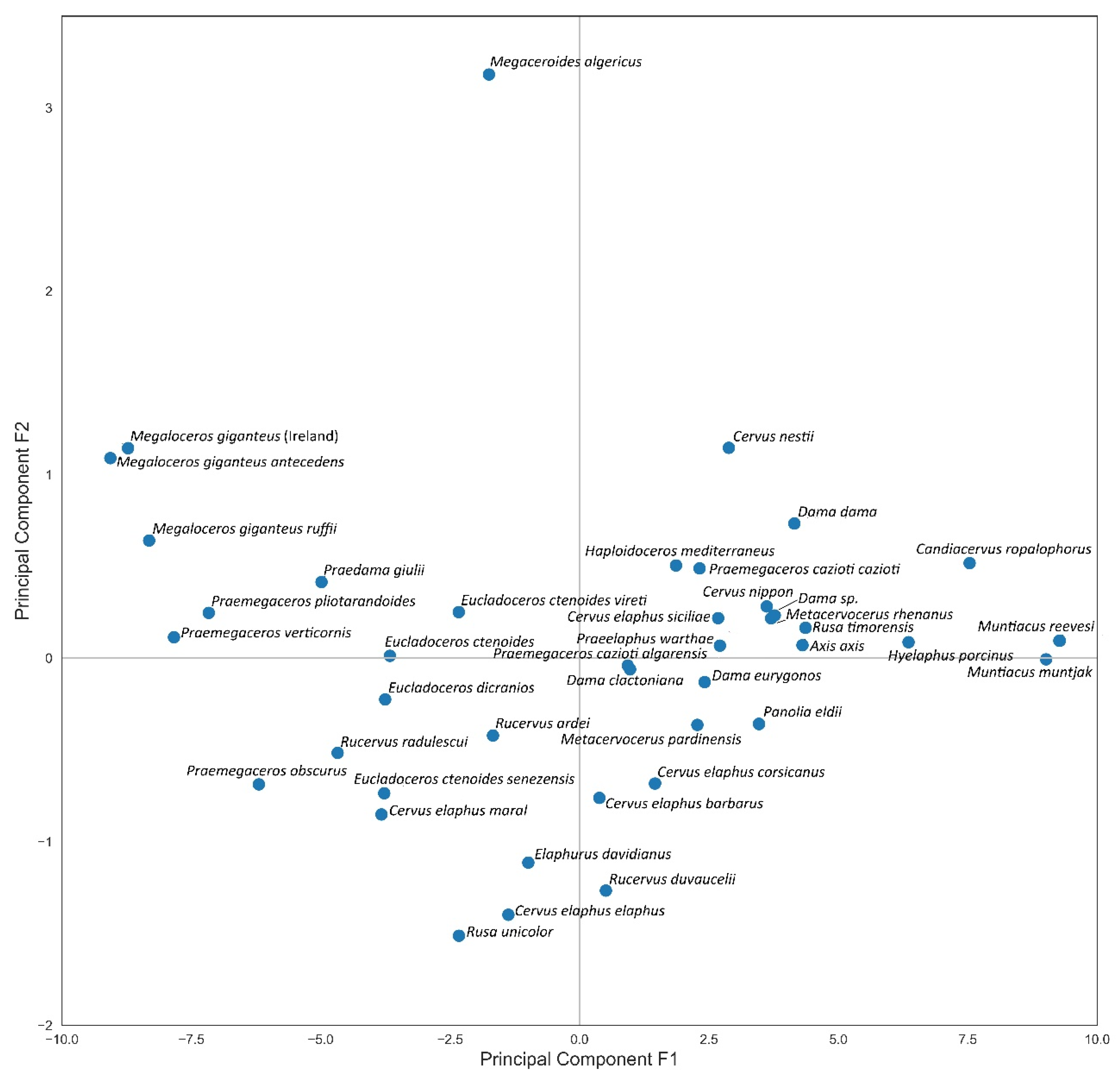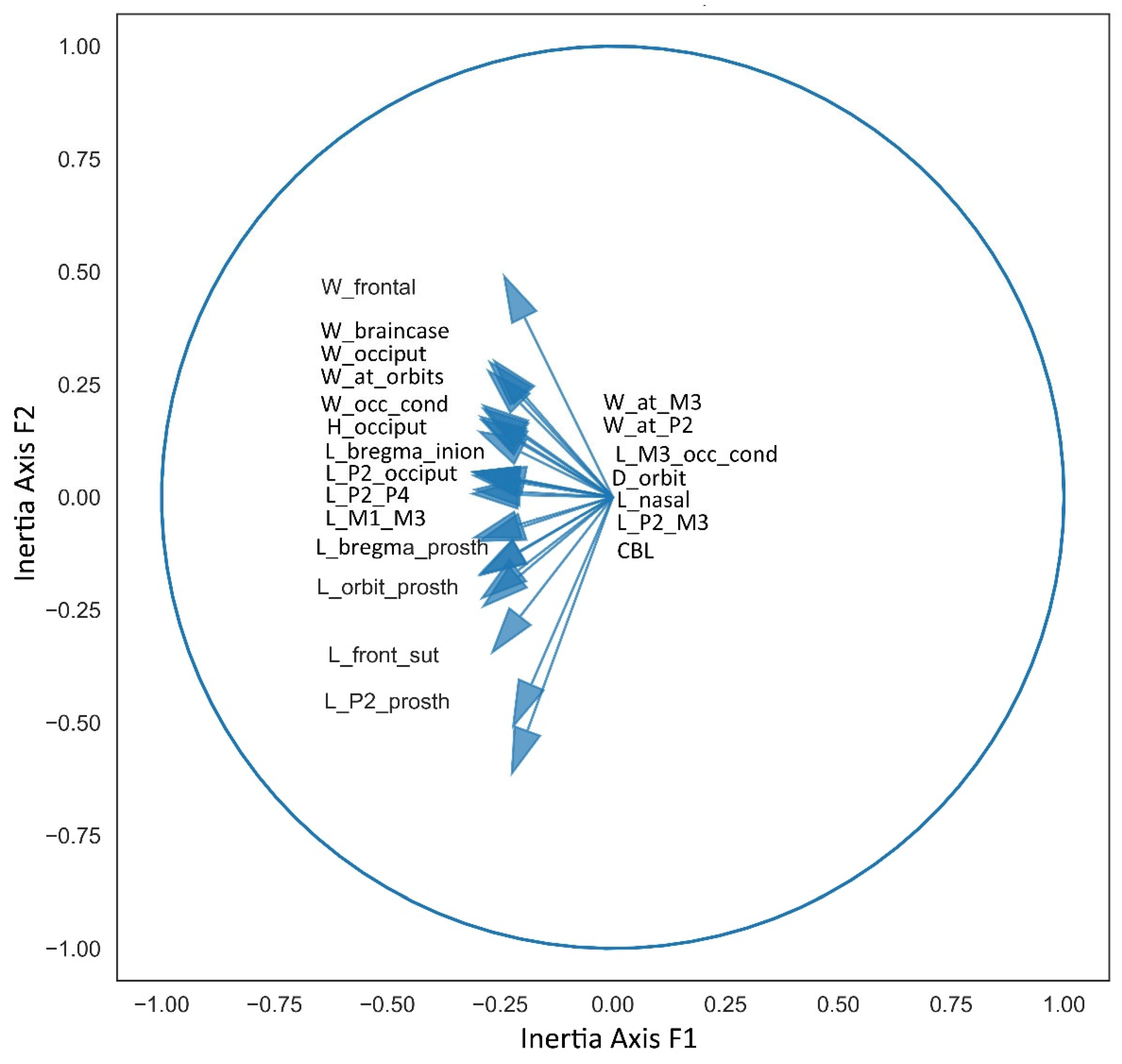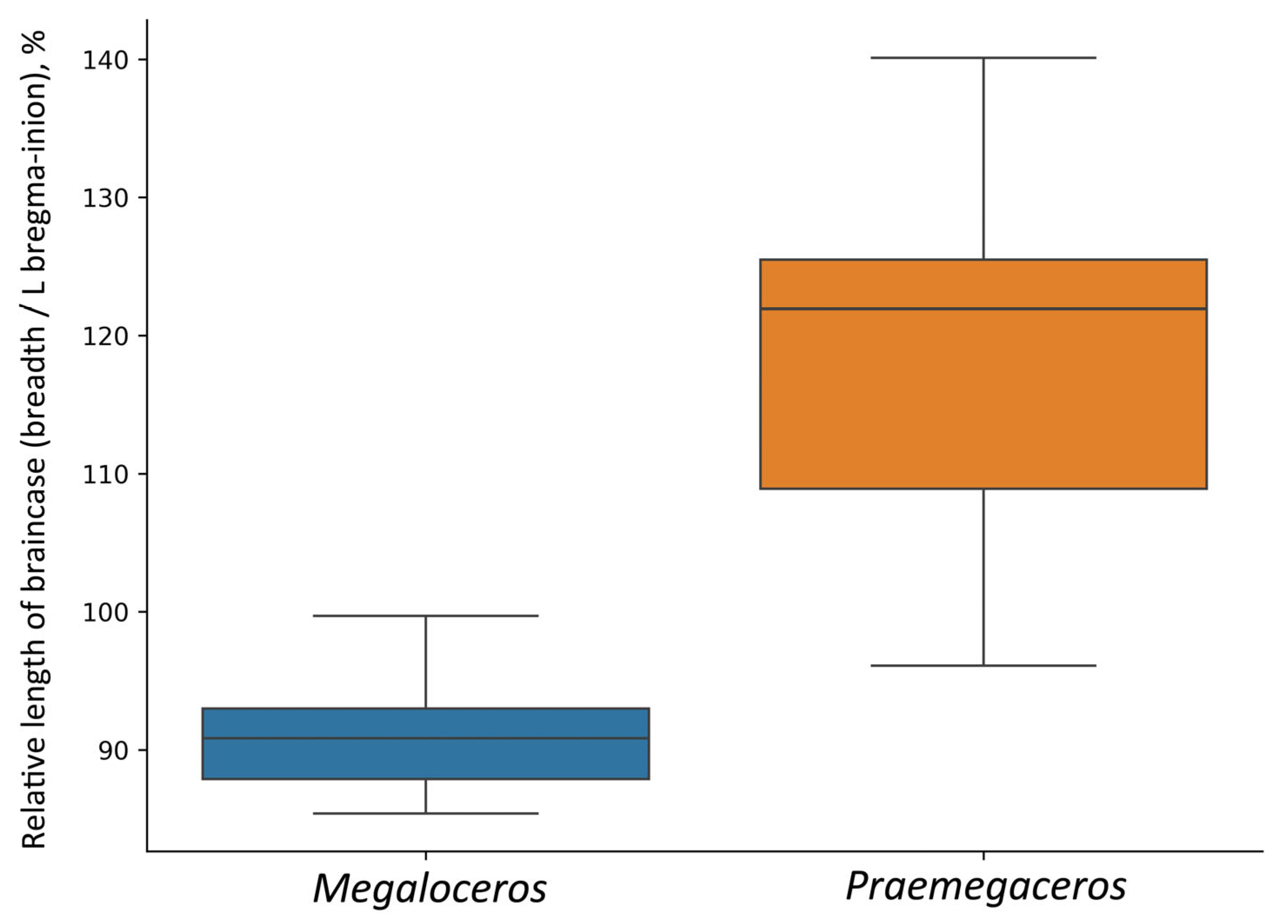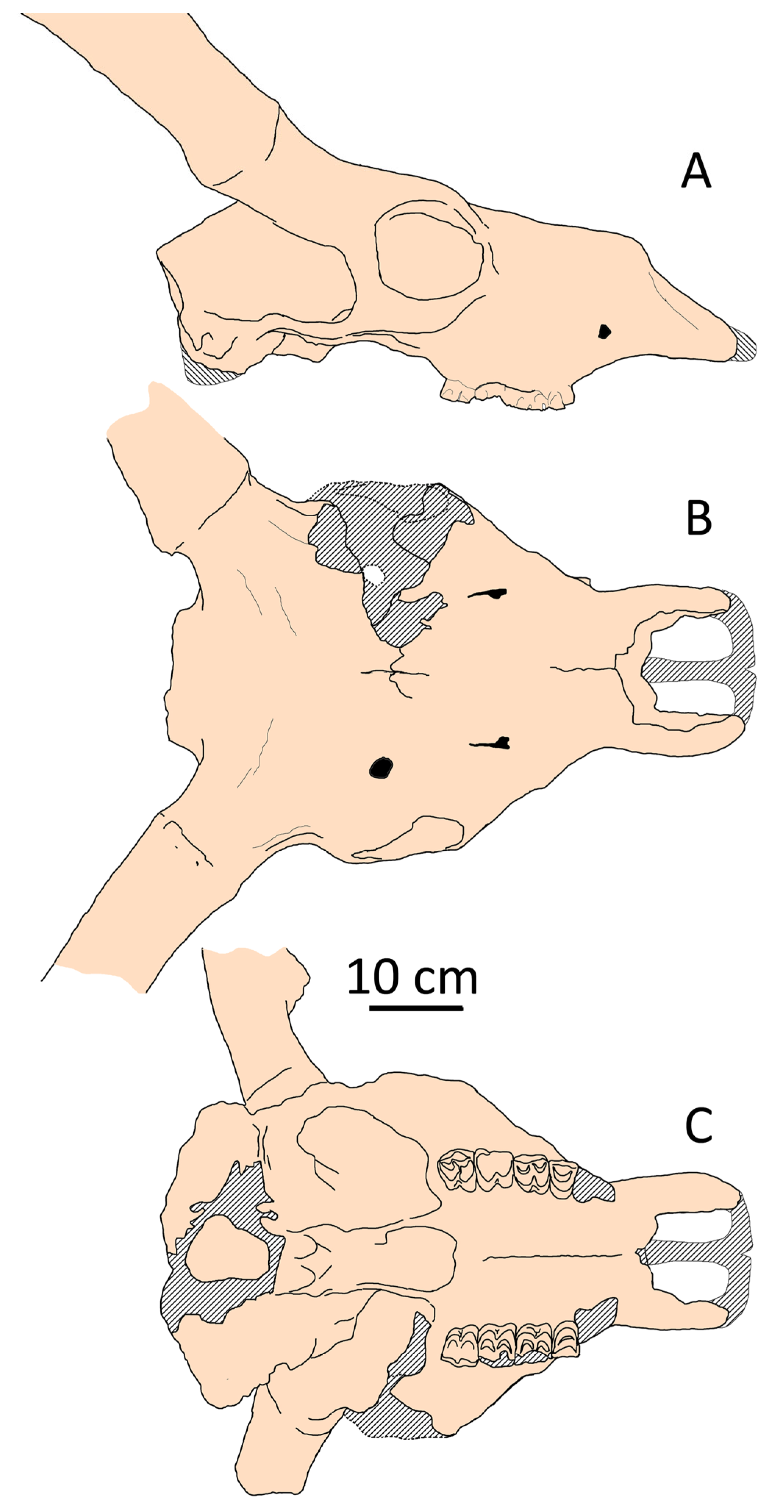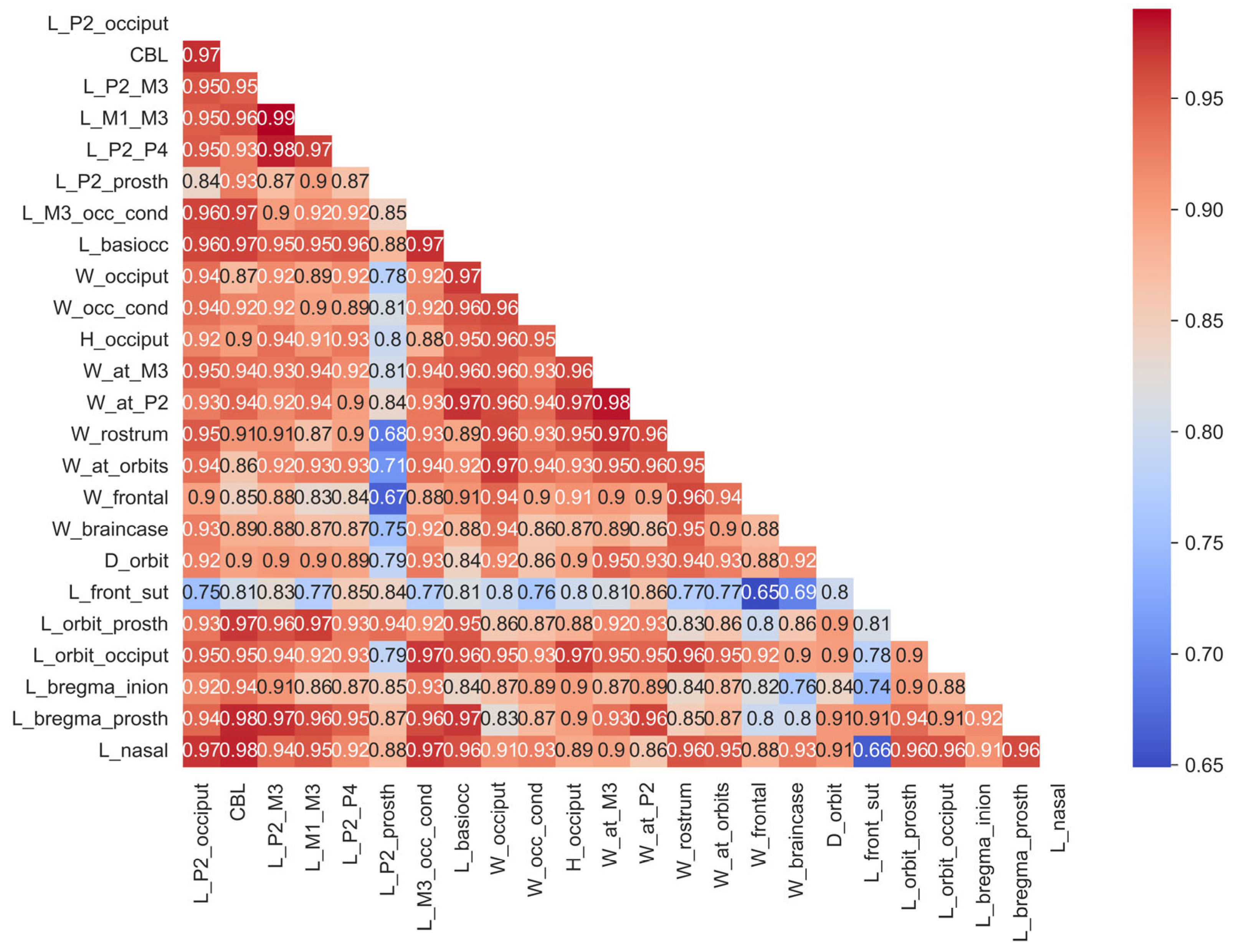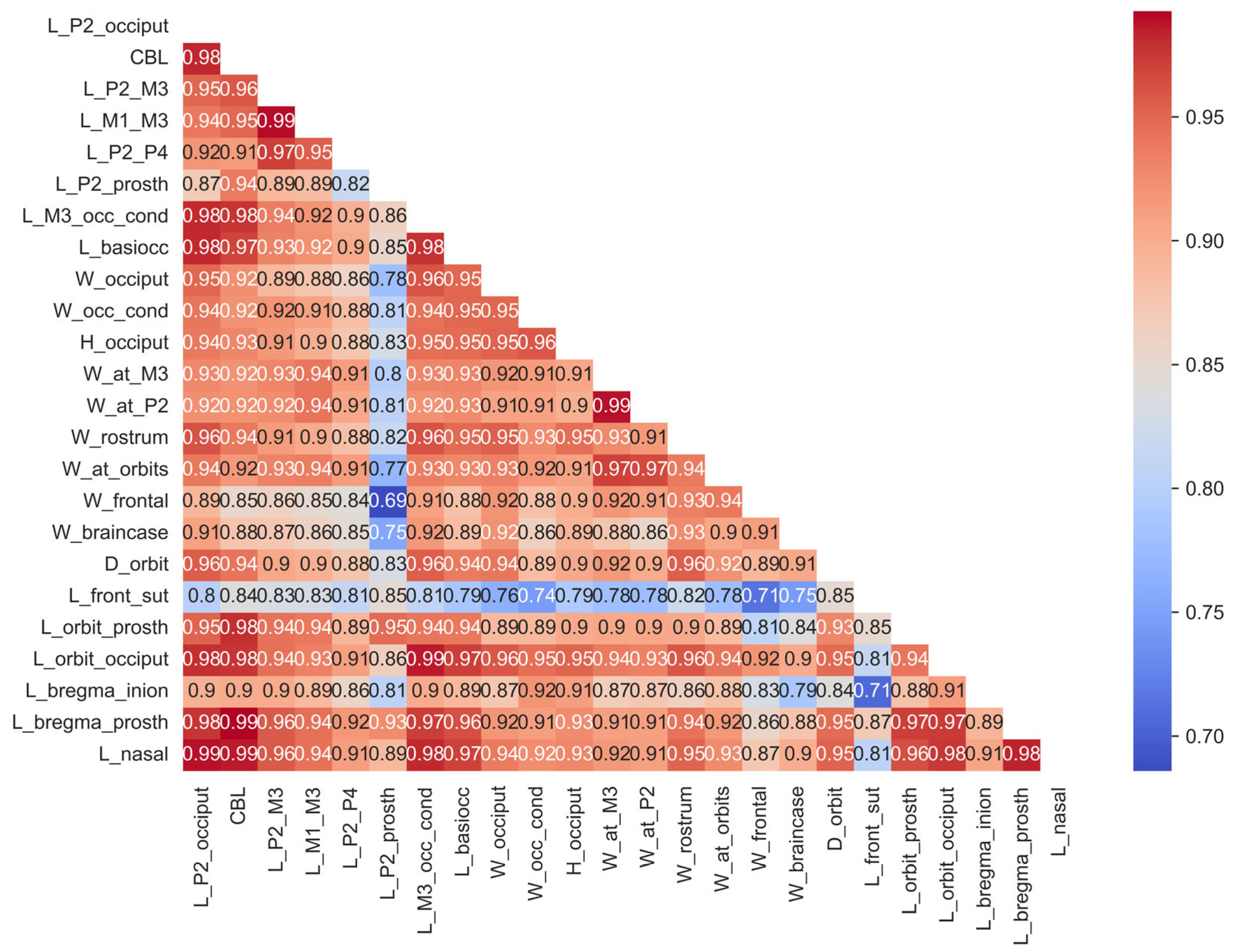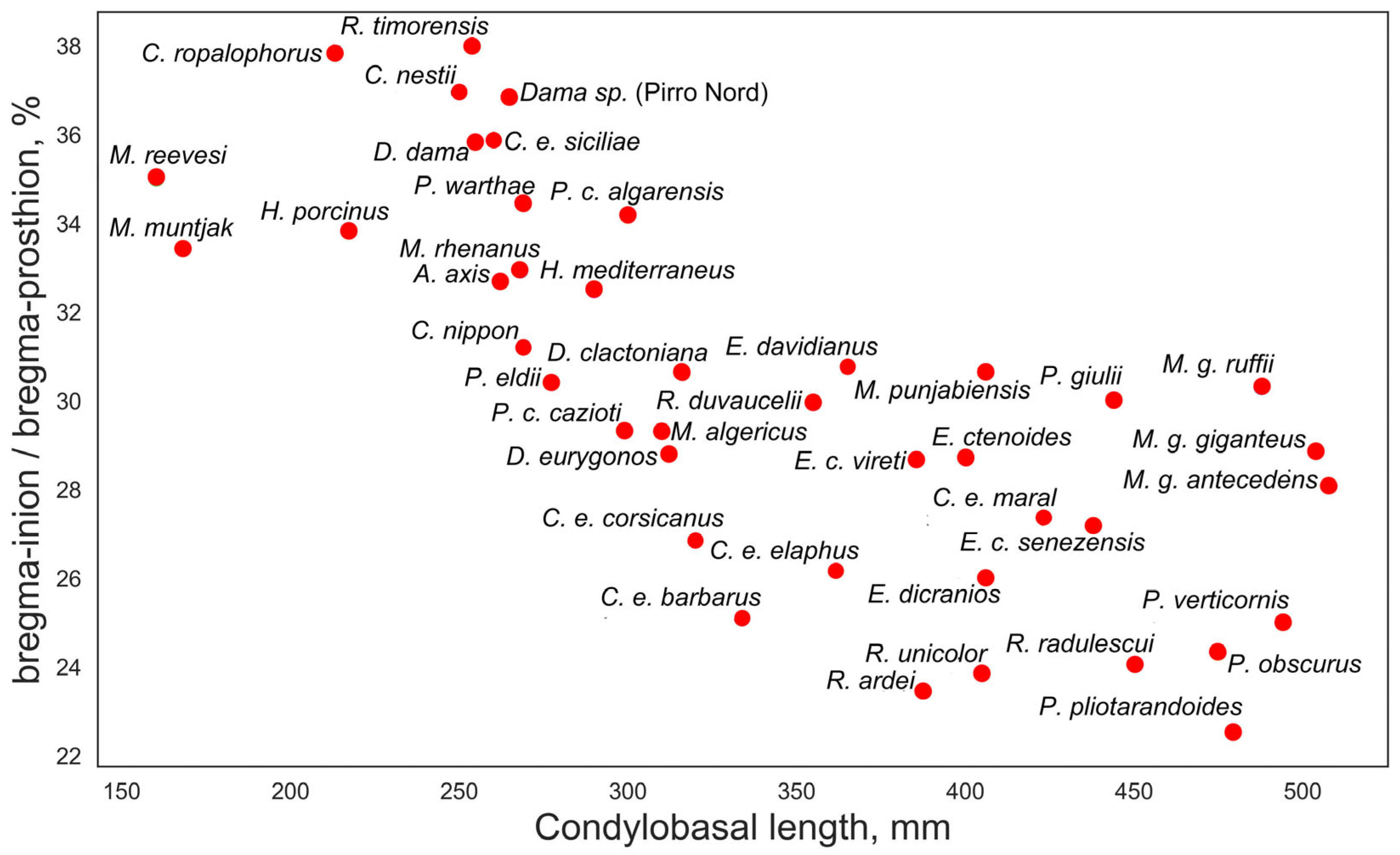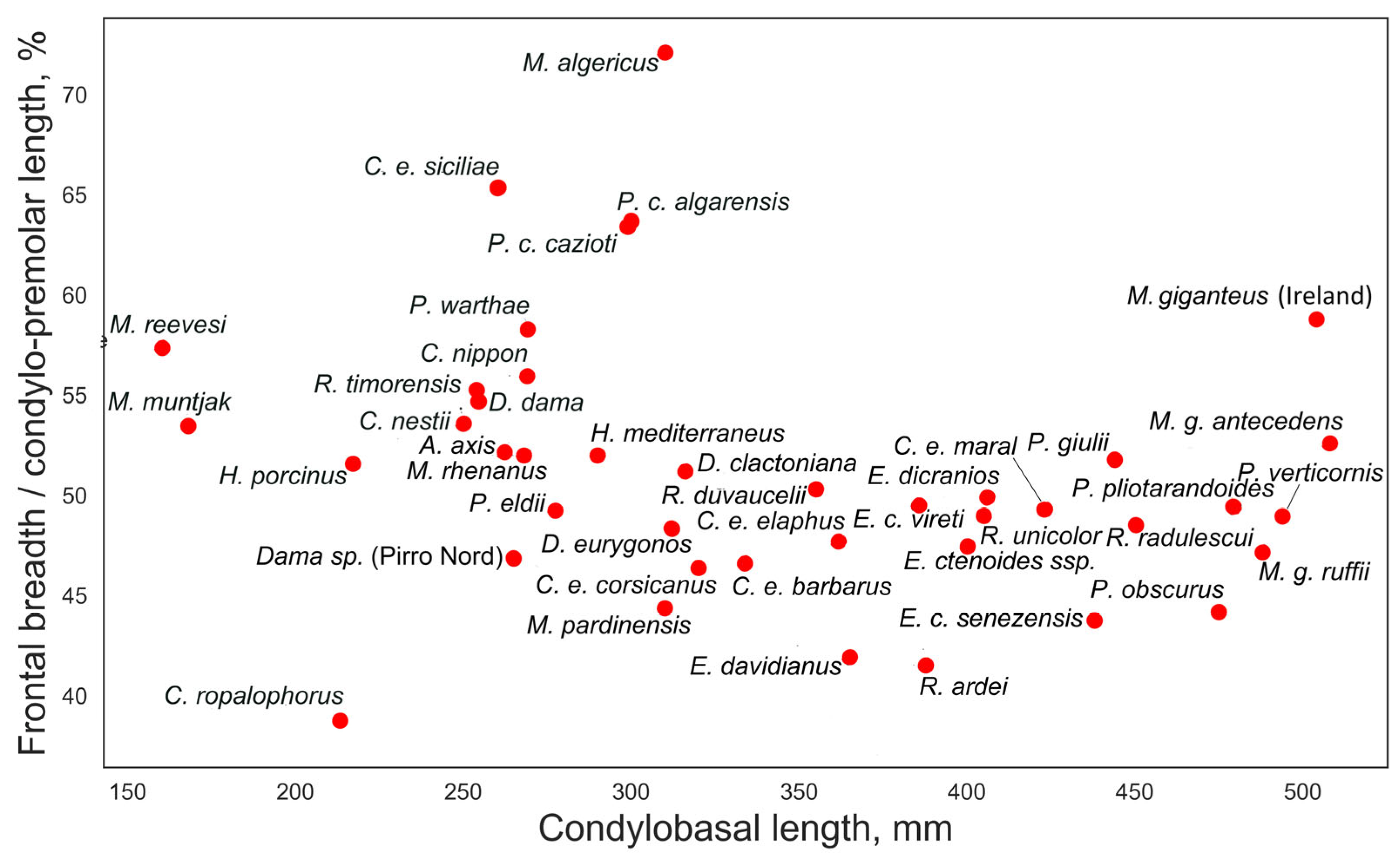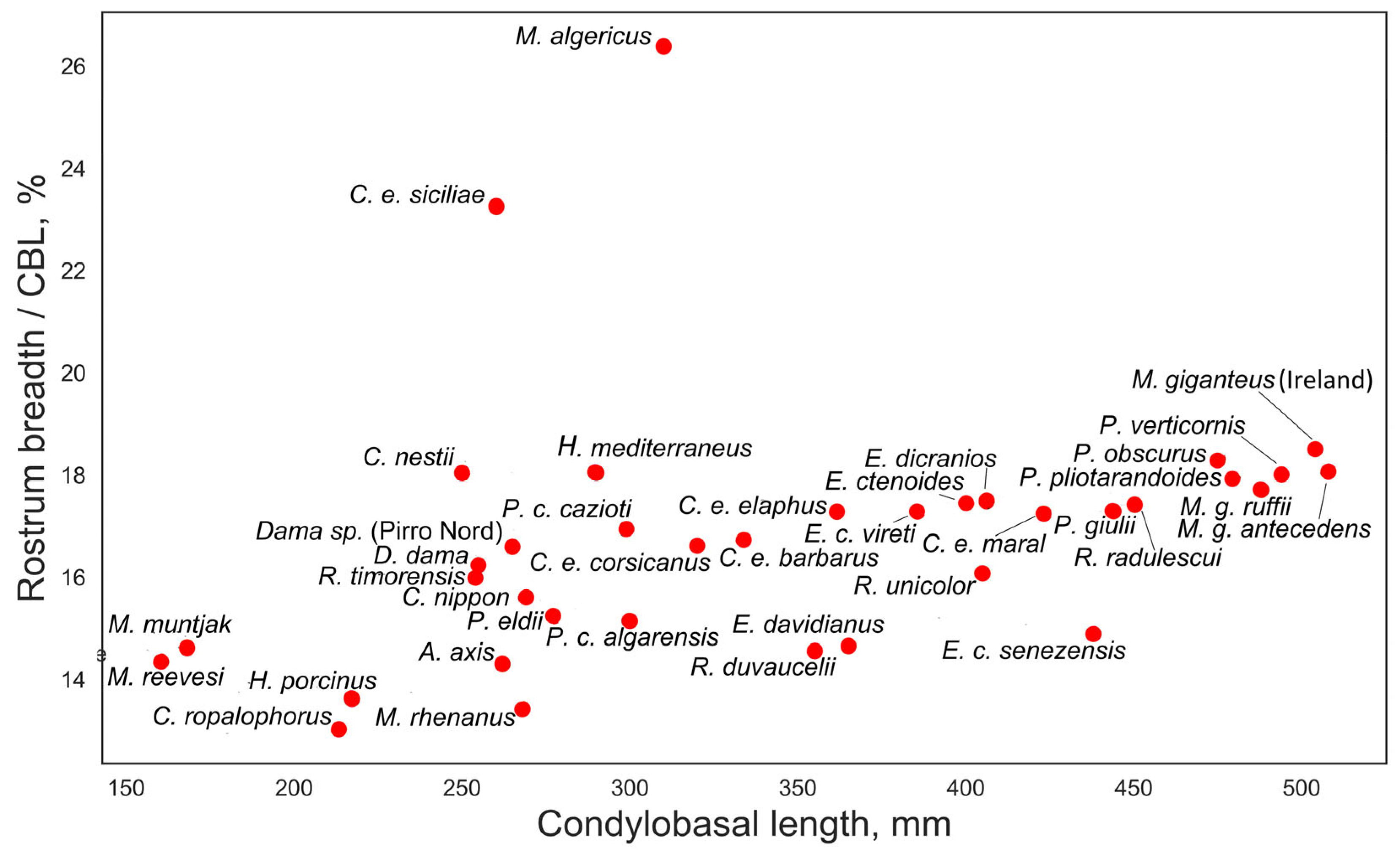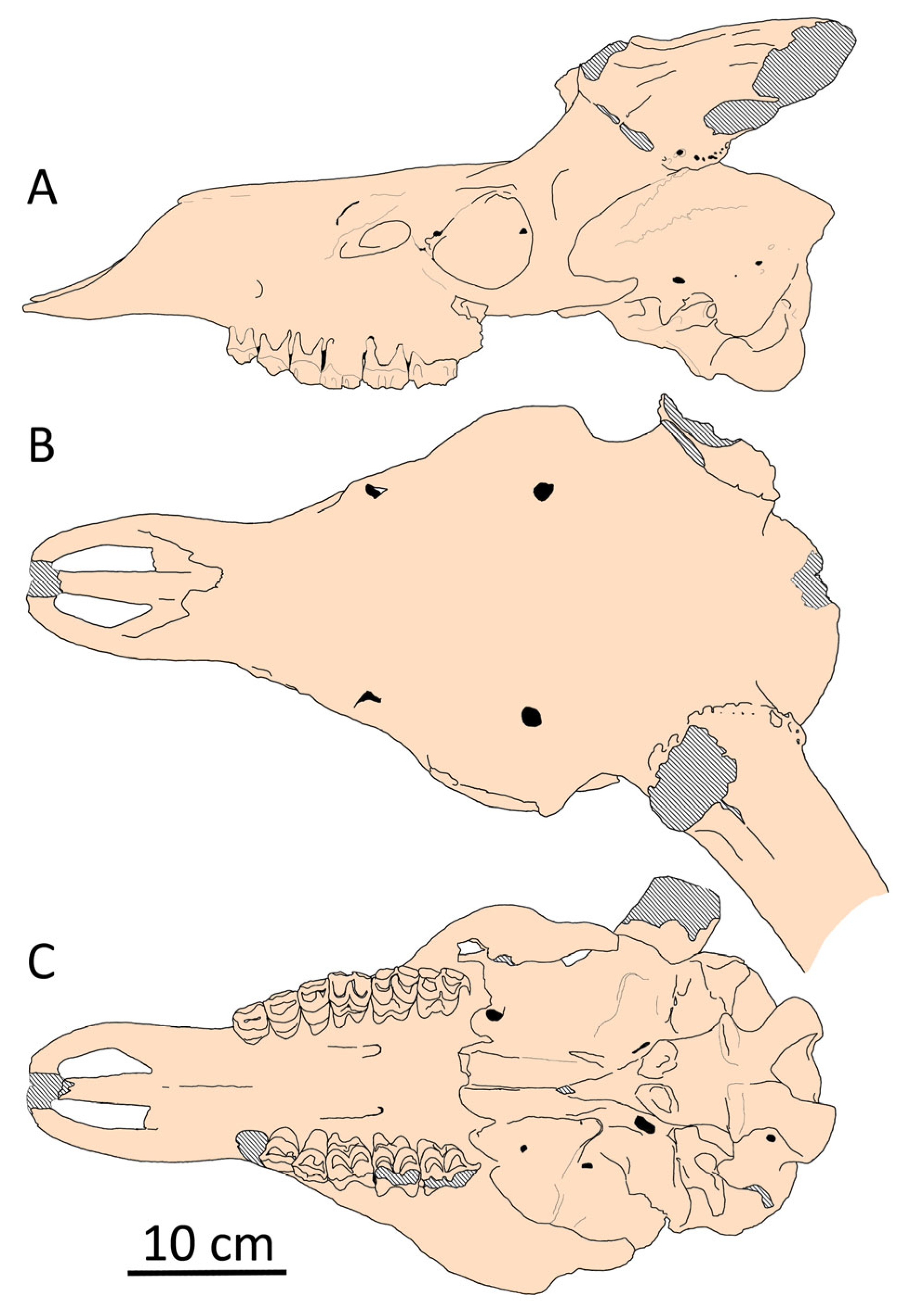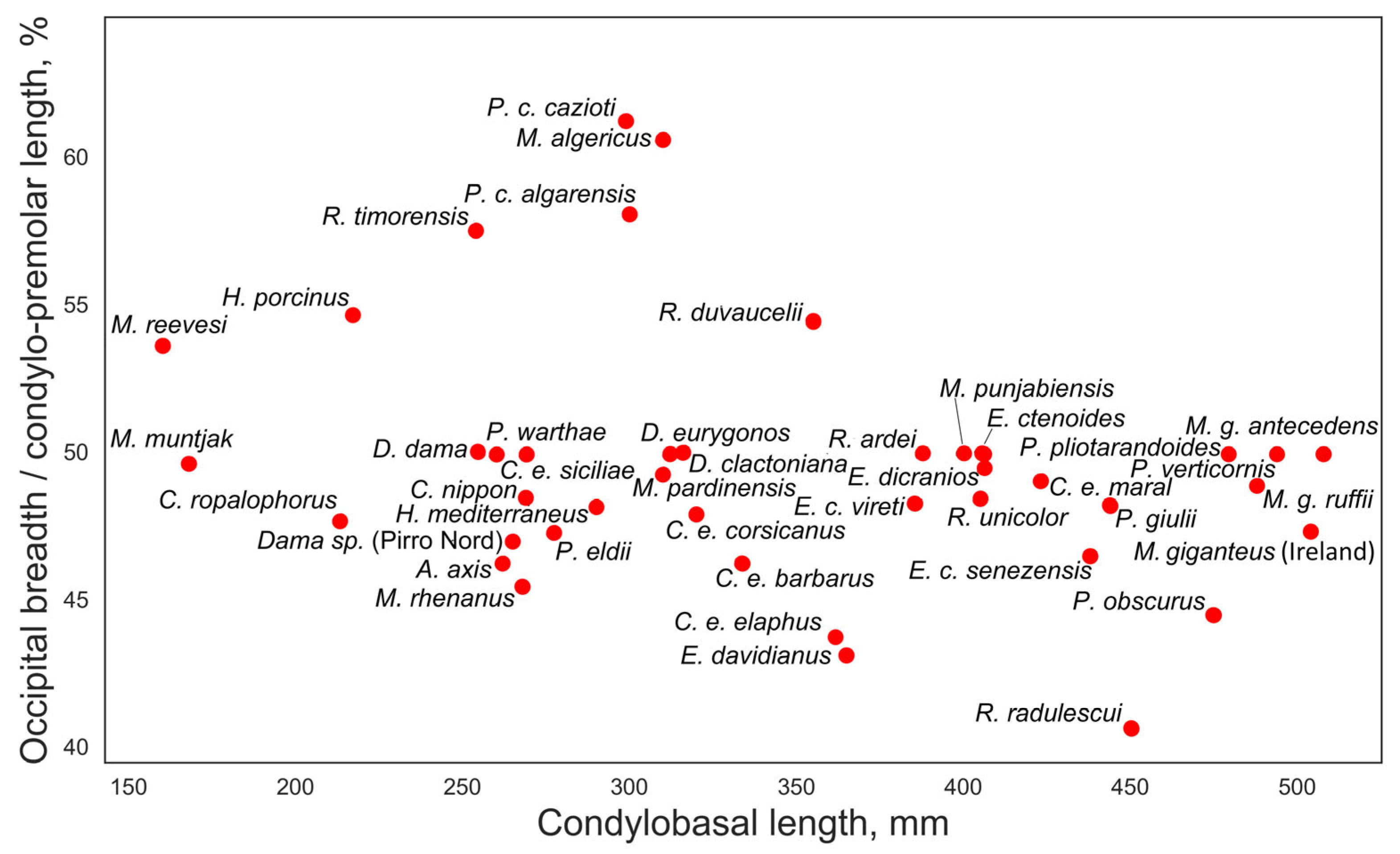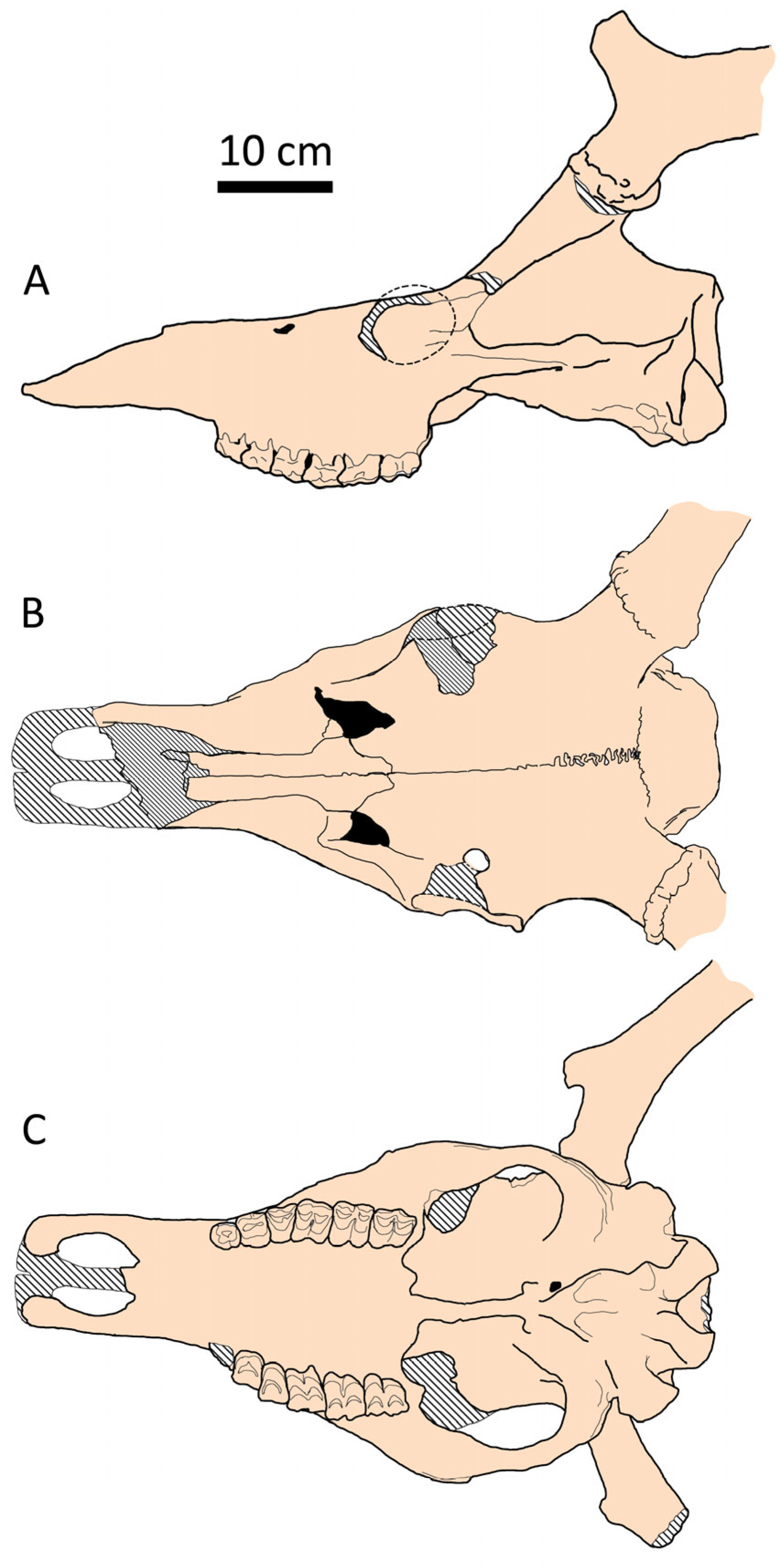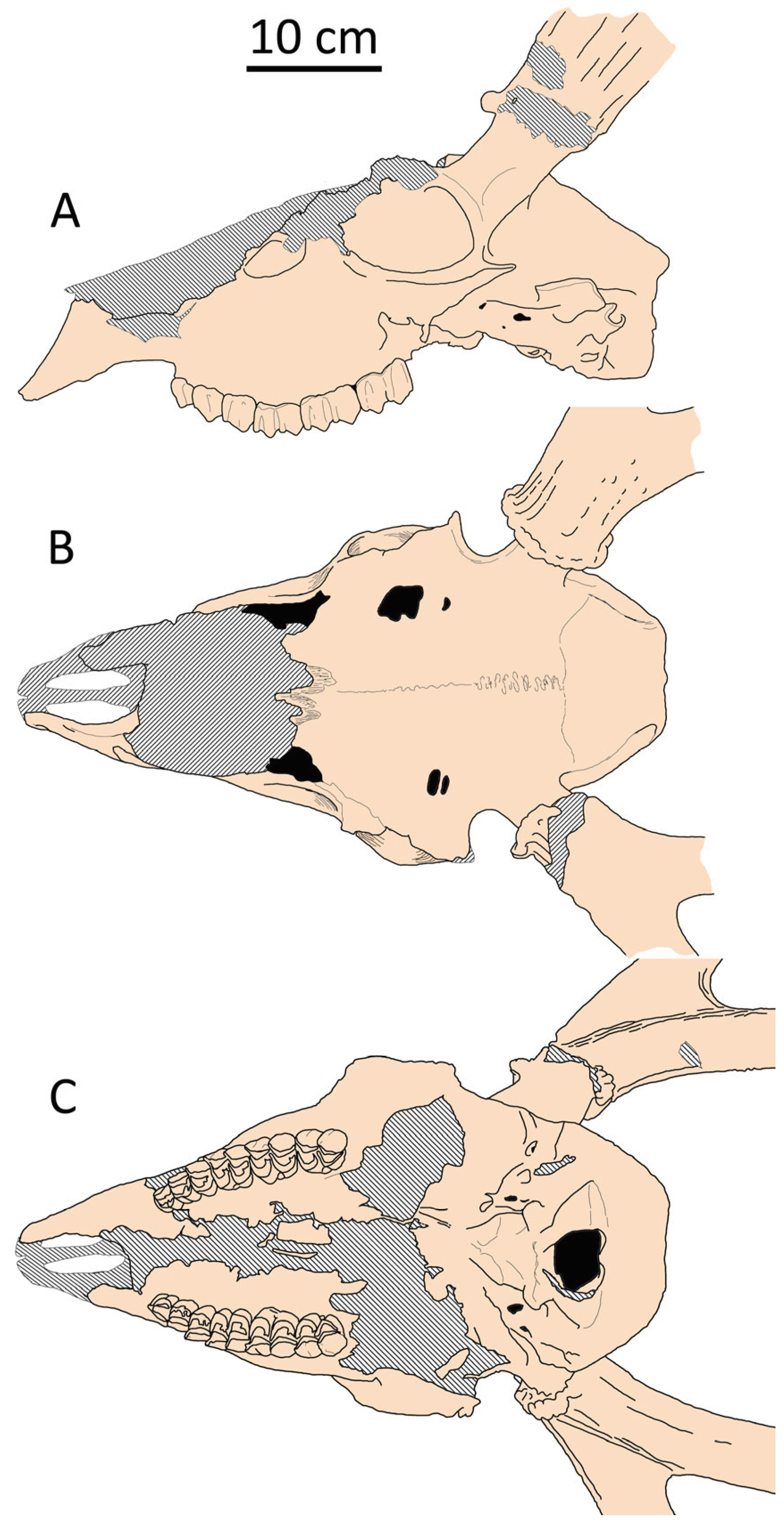4.1. Craniometric Diversity within the Subfamily Cervinae
The distribution pattern of species on the factorial map suggests several conclusions regarding the relationship between body size and ecomorphological diversity. Firstly, giant and large-sized deer display significantly broader ecomorphological diversity in cranial shape compared to small-sized deer. Secondly, small-sized deer exhibit greater uniformity in their cranial shape, appearing densely clustered on the factorial map. Thirdly, there is a gap in the continuum of cranial morphology that contributes to the V-shaped distribution of cervid species on the factorial map (
Figure 3).
The first two observations can be attributed to the unique digestive physiology of ruminants. Body size in ruminants imposes a corresponding rate of metabolism, which is lower in larger species and higher in smaller species [
16].
The complex anatomy of the four-chambered stomach includes the rumen, which serves as the primary site for microbial fermentation of ingested feed in ruminants. The duration of fermentation depends on the quality of forage, particularly the relative content of cellulose fibers in the ingested plant material. Fermented food particles can progress through the digestive tract via the reticulum only if they are small enough. Lower-quality forage increases fermentation time in the rumen, and in species with high metabolism, such as small ruminants, animals may experience starvation despite their rumen being filled with low-quality, hard-to-ferment forage [
16]. This limitation in forage quality is even more stringent in small male cervids, which require high-quality forage each year for antler growth.
As a result, smaller deer have a narrower range of digestible food resources, primarily limited to higher-quality forage. This eco-physiological constraint results in reduced diversity of cranial shape among small-sized cervids, which are adapted to similar forage, feeding height, and biomes. Given that cervid dentition and postcranial bones are even more uniform, distinguishing fragmentary remains of small cervids with similar body sizes becomes challenging. Differential and taxonomically meaningful characters become very subtle. As a result, the taxonomy and systematics of the so-called “small-sized deer” or “
Dama-like deer” remain subjects of long-lasting debates and disagreements [
17,
18,
19,
20].
In contrast, large and giant deer exhibit broader tolerance to forage quality due to their lower metabolic rates. Consequently, larger deer can occupy more diverse ecological niches, such as the modern large-sized tropical forest-dwelling Rusa unicolor, the extinct giant woodland dweller Praemegaceros obscurus, and the giant open landscape inhabitant Megaloceros giganteus.
The narrower availability of ecological niches in smaller cervids likely contributes to lower diversity in cranial shape. Conversely, the broader ecological tolerance of large and giant deer enables them to occupy a wider range of ecological niches, which underpins the greater diversity in cranial shape observed in large-sized deer.
The cause of the observed gap within the eco-morphological continuum of cervid cranial shape is not yet clear. It may be attributable to biomechanical limitations or ecological constraints.
The alignment of the skull craniometric characteristics of Muntiacus with the average type of the subfamily Cervinae is interesting because we do not find here a specific “primitive”, “archaic”, or paedomorphic craniometric condition that could be expected in very small tropical deer. This serves as one more argument in favor of the viewpoint that Muntiacus is a quite specialized genus characterized, besides the extreme reduction of lateral digits, by typical Cervinae cranial proportions, including a relatively short braincase.
4.2. Craniometric Features of Giant Deer
One of the most interesting results is the cranial shape specialization observed in
Megaloceros, which deviates from Vislobokova’s [
2] rule of ‘larger body size–longer splanchnoranium’. According to the position of the giant deer on the factorial map, it seems that the facial portion of
Megaloceros giganteus is relatively shorter than expected for a deer of such size (
Figure 3). However, the relative length of the muzzle, measured between the orbit and prosthion with respect to condylobasal length, in the giant deer
Megaloceros giganteus is actually the same as in
Praemegaceros obscurus. It measures 56.8% in the only complete skull of
Praemegaceros obscurus (IGF4024 from Pietrafitta); in
Megaloceros giganteus, this index varies between 54.1% and 59.4% (34 individuals, with a mean value of 56.9%).
Partially, this could be related to the relatively long and unflexed braincase (
Figure 8). Thus, the relative length of the braincase, expressed as a ratio of bregma–inion length to braincase breadth, ranges from 96.1% to 140% in
Praemegaceros (with 22 individuals belonging to
P. obscurus,
P. pliotarandoides, and
P. verticornis; the mean value being 118.2%), while in
Megaloceros giganteus, this ratio ranges from 85.4% to 99.7% (with 42 individuals, females excluded; the mean value being 90.9%) (
Figure 9). Overlapping values are represented by a very young individual of
Praemegaceros verticornis (Nr 1/229, Sucleia, Moldova) and an old individual of
Megaloceros giganteus (SMNS18360, Murr, Rhine Valley, Germany).
Partially, the small relative length of the splanchnocranium in
Megaloceros giganteus is related to its shortened orbitofrontal portion, a feature that distinguishes the giant deer from the long-muzzled
Cervus elaphus and
Elaphurus davidianus. Thus, the anterior edge of the orbit in
Megaloceros giganteus is situated above M
3 (
Figure 8), while in red deer and Pere David’s deer the downward projection of the anterior edge of orbit falls far behind M
3. However, the bregma point in giant deer is shifted caudally, as in all large-sized deer with a relatively long face (
Figure 5). Possibly, this feature is related to the increased size of the heavy antlers-bearing frontal bones, which are also relatively broad, especially in the giant deer from Ireland. The pedicles in giant deer maintain the common length and position observed in cervids; however, the frontal bones between pedicles are reinforced by extreme thickening, forming a strong bulge that creates a specific concave shape of the forehead before the pedicles [
21].
Figure 9.
Relative length of braincase in Megaloceros and Praemegaceros, calculated as the ratio of braincase breadth behind pedicles to bregma-inion distance.
Figure 9.
Relative length of braincase in Megaloceros and Praemegaceros, calculated as the ratio of braincase breadth behind pedicles to bregma-inion distance.
The most significant evolutionary specialization of
Megaloceros giganteus is its cranial pachyostosis, where the bones of the skull are significantly thickened compared to other cervid species. This adaptation most likely serves as a mineral storage mechanism necessary for the rapid growth of large antlers, particularly in environments with short vegetation periods [
22]. The cranial pachyostosis results in several specific features of the giant deer’s skull morphology. For instance, advanced ossification of the vomer, previously misunderstood as a feature aligning plesiometacarpal
Megaloceros with telemetacarpal representatives of the subfamily Capreolinae, characterized by a completely ossified vomer dividing the choanae. This feature is plesiomorphic for telemetacarpal deer and is not related to pachyostosis. Other cranial features associated with pachyostosis in giant deer include a reduced size of the foramen ovale, extremely reduced or completely closed ethmoidal openings, and the extreme thickening of mandibles, sometimes reaching an almost circular cross-section [
22,
23].
Despite these adaptations, cranial pachyostosis has had minimal influence on the general cranial shape and proportions of
Megaloceros giganteus. Specific morphological specializations include the strong caudal extension of nasal bones beyond the level of the anterior edges of the orbits [
23]. However, in many aspects, the cranial morphology of the giant deer remains primitive: the braincase remains unflexed, relatively long, and narrow of compared to the genus
Praemegaceros (
Figure 9). These morphological features, according to Vislobokova [
2], are primitive among cervids.
4.3. Specialization of Cranial Morphology in Megaceroides
Among cervid species, one of the most intriguing is
Megaceroides algericus from the Late Pleistocene of Northwestern Africa, which occupies an outlier position on the factorial plane (
Figure 3). This medium-sized endemic relative of
Megaloceros giganteus exhibits unique characteristics compared to other representatives of the subfamily Cervinae (
Figure 10). Similar to Eurasian
Megaloceros giganteus,
Megaceroides algericus displays significant cranial and mandibular pachyostosis [
24,
25]. However, the cranial pachyostosis in
Megaceroides serves a different adaptive purpose. Unlike
Megaloceros,
Megaceroides lacks a frontal bulge, with frontals appearing notably flat and broad, and its neurocranium exhibits moderate flexion. The overall cranial pachyostosis is more pronounced in
Megaceroides: eye socket rims are markedly thick, premaxillary bones are exceptionally broad and robust, and bone suture obliteration occurs early. In contrast, the zygomatic arches are thin and fragile, while cheek teeth are brachyodont and significantly reduced in size, particularly the third upper and lower molars [
25].
Megaceroides’ outlier position is attributed to its distinctive cranial shape, characterized by a broad and flattened braincase and frontals, and a relatively short muzzle—the shortest among continental deer (Figure). The facial portion between the orbits and prosthion is notably short, not exceeding half the length of the condylobasal measurement. The combination of a robust and broad skull with small cheek teeth and fragile, thin zygomatic arches is highly unusual, suggesting specific eco-morphological adaptations that differ significantly from those of most cervids. It’s noteworthy that
Megaceroides algericus is the only cervid species to have successfully entered and established itself on the African continent. The dispersal of
Megaceroides algericus into Africa occurred during the Middle Pleistocene via the East-Mediterranean dispersal route, indicating a lengthy evolutionary process in Northwestern Africa, which allowed for extreme specializations distinguishing this deer from Eurasian Cervinae.
The primary obstacle to cervid dispersal into Africa is ecological competition with the diverse and rich community of African bovids, which have evolved high ecomorphological specializations, posing strong competition for less specialized and opportunistic Cervidae [
4]. Consequently, successful cervid dispersal into Africa would require adaptation to a marginal ecological niche unoccupied by local African bovids. The combination of an extremely pachyostotic, broad, and flattened skull with small and partially reduced cheek teeth, along with thin zygomatic arches, may be interpreted as an adaptation to a periaquatic or semiaquatic ecological niche rich in soft, nutritious water plants but also fraught with the constant danger of attacks by dangerous water predators such as crocodiles [
25]. The broad premaxillary bones indicate an adaptation to feeding on soft water plants. Thus, the extremely thick and hard cranial bones serve as a protective helmet, a preadaptation inherited from its Eurasian predecessor,
Megaloceros giganteus, with initially different adaptation significance.
Figure 10.
Cranial shape of Megaceroides algericus from Guyotville (now Ain-Benian), Algeria (NMNH, ‘‘Collection Arambourg’’, no number): A, side view; B, dorsal view; C. palatal view.
Figure 10.
Cranial shape of Megaceroides algericus from Guyotville (now Ain-Benian), Algeria (NMNH, ‘‘Collection Arambourg’’, no number): A, side view; B, dorsal view; C. palatal view.
4.4. Insular Deer
The analyzed data comprise craniometric measurements of several species that are either considered insular or presumed to have been insular: modern Rusa timorensis from the islands of Java, Bali, and Timor; modern Cervus elaphus corsicanus from Corsica and Sardinia; the Late Pleistocene Cervus elaphus siciliae from Sicily; Praemegaceros cazioti from the Late Pleistocene of Corsica and Sardinia; and Candiacervus ropalophorus from the Late Pleistocene and Holocene of Crete. The results obtained did not reveal a specific “morphological syndrome” unique to all endemic insular deer.
The evolution of deer in conditions of insular isolation has long been recognized as a distinctive mode of evolution characterized by a suite of particular adaptations, forming a syndrome of responses to insular isolation. Among these adaptations, researchers often cite diminished body size, reduced and simplified antlers, shortened limb bones, abbreviated splanchnocranium, and generally paedomorphic cranial features [
12,
15,
26,
27]. Researchers have paid particularly close attention to Pleistocene insular deer of the Mediterranean. Azzaroli [
12] proposed that all extinct Mediterranean insular deer belonged to only two genera:
Megaloceros and
Cervus. Radulescu and Samson [
28] suggested that all extinct endemics from the Mediterranean islands should be grouped into a special genus,
Nesoleipoceros. However, subsequent studies revealed that the taxonomic situation in Pleistocene endemic deer of Mediterranean islands is highly complex, with more than two phylogenetically distant lineages that independently colonized Mediterranean islands [
26,
27,
29,
30]. Do insular cervids indeed follow a specific, predefined evolutionary trajectory across all cervid lineages that colonized islands? This study seeks to provide an answer.
Cervus elaphus corsicanus. Some Mediterranean insular deer, as noted by Azzaroli [
12], indeed belong to the genus
Cervus. Two insular forms of red deer are included in the present study: modern
Cervus elaphus corsicanus and extinct
Cervus elaphus siciliae.
Cervus elaphus corsicanus is one of the smallest modern forms of the red deer, characterized by simplified antlers with a diminished number of antler tines (missing bez tine and simplified crown), and a somewhat shorter facial portion of the splanchnocranium compared to the largest subspecies of red deer like
Cervus elaphus maral [
6,
14]. According to Flerov [
6],
C. elaphus corsicanus is actually not an insular deer and should be synonymized with Atlas deer
Cervus elaphus barbarus. This opinion was confirmed by archaeozoological studies [
31] and genetic studies [
32], which demonstrated that modern red deer from Corsica and Sardinia were introduced by humans. The mitochondrial haplotype of Corso-Sardinian red deer and North Africa reveals their relationship with the indigenous red deer population from the central part of the Italian Peninsula [
30]. Therefore,
C. elaphus corsicanus is a diminished form of the continental red deer. On the factorial plane, the Corso-Sardinian red deer is situated close to Atlas red deer, and both cervid forms are placed among continental deer (
Figure 3). According to our results,
C. elaphus corsicanus and
C. elaphus barbarus show very close cranial characteristics: moderate breadth of occiput with respect to condylopremolar length, much narrower than in many insular deer; frontal bones are moderately narrow and slightly narrower than in
C. elaphus elaphus and
C. elaphus maral. However, the frontal bones of Corsican and Atlas deer are significantly narrower than in other fossil Mediterranean deer and significantly narrower than in specialized insular endemic deer, such as
C. elaphus siciliae and
Praemegaceros cazioti. So, the craniometric data reveal the close cranial resemblance between supposed “insular”
C. elaphus corsicanus and continental
C. elaphus barbarus, thus confirming the possible synonymy between those two subspecies, if we still can speak about subspecies taking into account their artificial translocation from the Italian Peninsula [
31,
32]. Geist [
4] characterized the cranial shape of Atlas red deer as exhibiting paedomorphism. So, the craniometric data reveal that
C. elaphus corsicanus maintains cranial shape and proportions characteristic of continental deer and therefore does not show specific insular adaptations. The relative length of the facial part in
C. elaphus corsicanus is very close to that of continental red deer
C. elaphus elaphus. Concerning the simplified shape of antlers, they are known to be very sensitive to limited ecological resources [
33], therefore the diminished and simplified antlers of Corsican deer rather represent a phenetic response to environmental conditions than a genuine evolutionary adaptation to insular isolation. The body size of both
C. elaphus barbarus and
C. elaphus corsicanus generally corresponds to the size of continental Cervinae from the same latitudes (such as
Cervus nippon,
Panolia eldii, etc.), and therefore we cannot speak about a particular body size reduction.
Cervus elaphus siciliae. Craniometric features of C. elaphus siciliae reveal a distinct pattern suggestive of deep evolutionary transformation. This subspecies of red deer evolved in geographic isolation on Sicily Island during the Middle and Late Pleistocene. It is characterized by a diminished body size (approximately 80 kg) and reduced size of antlers, although they typically retain all elements such as brow, bez, trez, and crown tines. The three-pointed crown of C. elaphus siciliae indicates its relation to crowned forms of red deer, akin to C. elaphus maral or Cervus elaphus aretinus. On the factorial map, this deer is positioned among insular species like Praemegaceros cazioti and Rusa timorensis, as well as Mediterranean continental small-sized deer like Dama dama and Haploidoceros mediterraneus.
As noted by Gliozzi et al. [
34], the braincase of
C. elaphus siciliae is relatively short and shares proportions with continental European red deer forms. The authors also observed a notably narrow and high occiput, along with a relatively short muzzle in this insular deer. According to our data, the relative length of the face in
C. elaphus siciliae, measured as the distance between the anterior edges of the orbit to the prosthion, closely resembles that of
Cervus nippon,
Rusa timorensis, and
Dama dama. Remarkably,
C. elaphus siciliae is the only subspecies of red deer with a rostrally shifted bregma point (
Figure 5). One of its most striking morphological features is the relatively broad frontals, broader even than those of giant deer from Ireland (
Figure 6). Some features of
C. elaphus siciliae suggest an adaptation to grazing: the relative breadth of the rostrum is extreme for cervines, reaching approximately 23% of the condylobasal length (
Figure 7). Additionally, premaxillary bones are square-shaped, while maxillary bones exhibit strongly developed rugosity for the attachment of
musculus masseter [
34]. The ecomorphological features of
C. elaphus siciliae are quite similar to those seen in
Praemegaceros (
Nesoleipoceros)
cazioti from the Late Pleistocene of Corsica and Sardinia.
Praemegaceros cazioti.
Praemegaceros (
Nesoleipoceros)
cazioti evolved from the giant continental deer
Praemegaceros (
Nesoleipoceros)
solilhacus, which is known from the Early Middle Pleistocene of Europe [
26]. The evolutionary relationship between the continental giant
P. solilhacus with large palmated antlers (approximately 400 kg in body mass [
23]) and the insular Corso-Sardinian endemic
P. cazioti is primarily inferred from the similarity of antler shape, and both species are classified within the subgenus
Nesoleipoceros of the genus
Praemegaceros.
Praemegaceros cazioti is characterized by a significantly reduced body size (estimated body mass approximately 80-100 kg [
26]) and a vestigial character of antler palmation. Thus, during the evolutionary transition from
P. solilhacus to
P. cazioti, the lineage of
Nesoleipoceros experienced a 4-5 fold reduction in body size.
Unfortunately, we do not have at our disposal a complete skull of
P. solilhacus, but the cranial material of the better-known
Praemegaceros obscurus [
35] can provide insight into the cranial transformations during the reduction in body size as an adaptation to insular isolation.
Both subspecies,
P. cazioti cazioti and
P. cazioti algarensis, are positioned among “
Dama-like” deer on the factorial plan (
Figure 3). The frontal bones in
Praemegaceros cazioti are flat and relatively very broad, comparable in breadth to those of
C. elaphus siciliae (
Figure 6). Unlike
C. elaphus siciliae,
P. cazioti is characterized by an exceptionally broad occiput (
Figure 11), comparable to that of
Megaceroides algericus in its relative breadth calculated to premolar-occipital length (excluding the variable part of the skull between P
2 and prosthion). A similarly broad occiput is also observed in
Rusa timorensis. The functional significance of such extreme occipital breadth is not immediately evident. Geist [
4] explained the relatively broad occiput in
Hyelaphus porcinus as having a functional role in accommodating strong neck muscles needed to stabilize the animal’s head during fast locomotion through tall and dense grass. While the occiput in hog deer is indeed relatively broader than in most cervines, it is not as extremely broad as in
P. cazioti and
R. timorensis. Perhaps the relatively broad occiput in
P. cazioti is another morphological remnant from its giant ancestor. However, the presence of this feature in
R. timorensis suggests that this morphological peculiarity may have a more complex evolutionary origin.
The nasal bones in
P. cazioti are short, with their posterior edge not reaching the line connecting the anterior edges of the eye sockets [
26]. The area of
musculus masseter insertion is clearly defined and extends forward until the level of M
1. The orbitofrontal region is shorter compared to continental species of the genera
Eucladoceros and
Praemegaceros [
26,
36,
37]; in lateral view, the anterior edge of the orbit is situated at the level of M
2. The premaxillary bones are broad, robust, and square-shaped [
36,
37,
38], resembling those of
Cervus elaphus siciliae, suggesting similar adaptations to grazing (
Figure 12). One of the most interesting morphological features of
P. cazioti cazioti is the more caudal position of the bregma point (
Figure 5), indicating the retention of some characteristics typical of giant continental deer.
However, the grazing adaptations in
P. cazioti cazioti are still moderate and do not significantly alter its craniodental morphology [
26]. Thus, the upper cheek tooth-row exhibits a relative length typical of cervinae, remaining below 30% of the condylobasal skull length. The skull proportions of
P. cazioti cazioti from Coscia (Corsica) remain largely similar to those of
P. obscurus from Pietrafitta, except for a slightly shorter face, which nonetheless maintains a similar relative length compared to mainland deer of similar size. Both insular
P. cazioti cazioti and mainland small-sized species share similarities in the position of the upper tooth row, the relative length of the P
2-prosthion distance, and the relative length of the upper dentition [
26,
36,
37,
38].
Praemegaceros cazioti algarensis from Dragonara (Sardinia) exhibits more evolved grazing adaptations: its square-shaped praemalillare are notably broad; the area of musculus masseter insertion is extensive, bordered with prominent ribs, and extends forward until the level of P
4 [
37,
38]. The upper tooth row is relatively long, reaching 33.7% of the condylobasal length, and the cheek teeth have remarkably higher crowns, classified as mesodontous [
26,
37]. The orbitofrontal portion is very short, with the anterior edge of the orbit positioned at the level of the posterior edge of M
2 (when projected onto the upper tooth row plane), and the distance between P
2 and the prosthion is notably short (24.5% of the condylobasal length). Unlike
P. cazioti cazioti, the bregma point in
P.
cazioti algarensis is shifted rostrally, as observed in all small-sized deer (
Figure 5). The difference in the position of the bregma point between
P. cazioti cazioti and
P. cazioti algarensis is likely related to the shortening of the facial part: the relative length of the muzzle, measured from the anterior edges of the orbits to the prosthion with respect to the condylobasal length, is 56% in the former subspecies and approximately 50% in the latter.
The morphological and craniometric similarities between C. elaphus siciliae and P. cazioti should be considered more as a convergence than parallelism. Both deer exhibit exceptionally broad frontal bones, a trait likely inherited from their large-sized or giant ancestors as a consequence of significant body size reduction. This disproportionally broad feature of the frontal bones may share a similar nature to that observed in Megaceroides algericus. Thus, in small-sized deer, disproportionally broad frontal bones may serve as an indicator of considerable evolutionary size reduction.
Candiacervus ropalophorus. The genus
Candiacervus encompasses insular deer native to Crete, which have undergone extreme reduction in body size and significant cranial shape transformation due to evolution in isolated island conditions [
12,
15,
27,
29]. The body size of
Candiacervus species falls between that of
Hyelaphus and
Muntiacus. Possibly, the genus
Candiacervus evolved from the continental giant deer
Praemegaceros obscurus or
Praemegaceros verticornis. The evolutionary relationship between
Candiacervus and
Praemegaceros is apparent from the antler shape of
Candiacervus listeri, considered the less specialized representative of the genus
Candiacervus, which retains key characteristics of antler morphology from its continental precursor. The antlers of
Candiacervus listeri preserve all structural elements seen in
Praemegaceros [
23,
28,
35], including the dorsal (outer) tine, middle tine, and the sharp bend in the area of the posterior tine, albeit reduced in
C. listeri [
27]. Additionally,
C. listeri maintains the shape and position of compressed and divergent pedicles [
27] observed in advanced continental
Praemegaceros [
23].
The antlers of
Candiacervus ropalophorus are the most specialized within the genus, retaining only the middle tine and featuring a very long beam with a mace-shaped distal end [
27]. This deer exhibits advanced cranial adaptations to insular conditions, positioning it somewhat marginally on the factorial map, though not as an extreme outlier (
Figure 3).
Candiacervus ropalophorus is characterized by a significantly reduced relative length of the facial part of the skull [
15]. The measurement from the orbit to the prosthion point attains 30% of the condylobasal length, representing an outlier value among cervines, where the relative length of the face typically ranges from 50 to 65%. The position of the bregma point is strongly shifted rostrally, with the ratio of bregma-inion to bregma-prosthion amounting to 38%, which is also an extreme value among Cervinae, shared only with
Rusa timorensis (
Figure 5). The relative length of the cheek teeth attains 30% of the condylobasal length, a common value among representatives of the subfamily Cervinae.
Frontal bones in C. ropalophorus are flat, with moderately diverged and backward-pointing pedicles, resembling those in continental advanced Praemegaceros. However, frontal bones are relatively very narrow, showing the lowest value among Cervines. Possibly, the peculiar narrowness of frontals in C. ropalophorus is related to the shortened and diminished facial portion of the cranium. Similarly, C. ropalophorus has the narrowest rostrum among Cervinae, although its premaxillary bones are square-shaped, as seen in other endemic Mediterranean insular deer with grazing adaptations.
Among the morphological peculiarities of the splanchnocranium in
C. ropalophorus, one can notice its very low profile. This morphological peculiarity is shared with
Praemegaceros cazioti (
Figure 12) and is supposed to be related to the diminished volume of the nasal cavity. One plausible explanation for this peculiar feature in insular deer is their diminished olfactory capacities in the absence of carnivores in the insular ecosystem [
26]. The braincase of
C. ropalophorus is relatively short, as in continental
Praemegaceros [
15], while its occiput maintains a normal relative breadth for cervinae (
Figure 11).
Thus, our study could not reveal a universal type of insular dwarfed deer, as each insular species inherits specific morphology from its continental ancestor and is characterized by its own degree of evolutionary adaptation to insular conditions. The character and completeness of the local insular fauna (the so-called “balanced insular faunas”, i.e., faunas containing predators, that is very rare in endemic insular faunas) are another important factors that shape the evolution of insular deer [
13,
39]. However, we can recognize some common morphological and craniometric features that mark the evolutionary diminishment of body size, such as disproportionately broad frontal bones and occiput in the early stages of evolutionary insular dwarfing, as well as the progressive shortening of the splanchnocranium and rostral shift of the bregma point.
4.5. “Dama-Like” Deer
The body size, similar to that of modern fallow deer, appears to hold pivotal importance in the subfamily Cervinae, and likely within the entire cervid family. This body size is common among continental species inhabiting warm latitudes of the Holarctic and the Oriental zoogeographic realm (Croitor). In the examples of insular deer discussed in this study, we have observed that body size reduction—especially in the early stages of evolution under insular isolation—can lead to deer reaching a size similar to that of fallow deer. However, insular isolation is not a prerequisite for evolutionary body size reduction to this extent. Examples from the continental paleontological record also exist. One such example is
Haploidoceros mediterraneus, a small to medium-sized deer that evolved in the northwestern Mediterranean region during the Middle and Late Pleistocene (Croitor et al., 2020). The genus
Haploidoceros underwent at least three million years of evolution in the warm and relatively dry conditions of the Pliocene in Western Europe and in the Mediterranean conditions of the Pleistocene glacial refugium of the Iberian Peninsula. Based on cranial variables, its body mass is estimated to be around 70-80 kg [
40], considerably smaller than its presumed ancestor,
Rucervus (
Arvernoceros)
ardei, with a body mass of approximately 180 kg [
41]. Therefore, the evolution of the
Haploidoceros lineage involved roughly a two-fold reduction in body mass. This reduction in body size appears to be an adaptation to the ecological niche of “
Dama-like” deer within the Early Pleistocene Mediterranean ecosystems.
H. mediterraneus is characterized by unusually specialized antlers, consisting solely of a very long sickle-shaped beam and a single large basal tine [
40]. The evolutionary reasons for antler simplification in
Haploidoceros are not yet understood. The craniodental morphology of
H. mediterraneus is also peculiar and does not provide a straightforward answer regarding the species’ dietary specialization. The relatively large cheek teeth (32-33% of condylobasal length) and short diastema in
H. mediterraneus from Cova del Rinoceront (Spain) resemble the grazing adaptations of
P. cazioti. However, the shape of narrow and pointed premaxillary bones (
Figure 13) differs from the broad and rectangular-shaped premaxillaries of
P. cazioti. The premaxillary bones of
H. mediterraneus are even narrower and more pointed than those of fossil and modern fallow deer (
Figure 13), approaching those of specialized browsers. Thus, the masticatory apparatus of
H. mediterraneus represents several superimposed morphological adaptations resulting in an unusual combination of features: relatively large cheek teeth and narrow, pointed premaxillary bones, akin to browsing herbivores. The protruding telescopic (or tube-shaped) orbits are a distinguishing morphological feature of
H. mediterraneus. The development of tubular orbits is most likely related to the long hair on males’ heads and necks, which could serve as protection against rivals’ simplified antlers during intraspecific combat [
40]. Among other advanced cranial morphological specializations are short and diverged pedicles and a flexed braincase (
Figure 13). However, despite numerous highly specialized morphological features, the skull of
H. mediterraneus maintains generalized proportions characteristic of most less specialized small-sized Cervinae and is grouped with small-sized deer like
Axis and
Dama on the factorial plane (
Figure 3).
The term “
Dama-like deer”, proposed by Di Stefano and Petronio [
19], carries deeper significance, as it refers to an eco-morphological type of small-sized deer that evolved independently in several phylogenetic lineages due to common eco-physiological and biomechanical constraints shared by all cervids. However, despite the similarity in craniometric characteristics, the systematic position of these small-sized deer can be deduced from morphological details of their skull, dentition, and antlers, which hold taxonomic and systematic significance [
20].
The “Dama-like deer” represents a fundamental eco-physiological type among cervids, encapsulating key ecological and physiological traits relevant to their roles within ecosystems. This concept describes a set of characteristics essential for optimal metabolism, reproduction rates, and antipredator strategies tailored to specific ecological conditions. Associated with this eco-physiological type are distinct craniometric features influenced by shared ecological niches and food resource characteristics.
Given that the ecological and evolutionary strategy of the Cervinae subfamily often revolves around nutrient-rich foraging grounds, this fundamental eco-physiological type holds universal significance, occupying a central position within cervid diversity. However, external factors such as predation pressure, changes in food quality, and interactions with other herbivores can lead to the evolution of various forms within the cervid lineage, including giant forms, small Muntiacus-like forms, or other eco-physiological types, depending on the new ecological niches they inhabit. Yet, when these external pressures diminish, cervid lineages tend to revert to their fundamental eco-physiological type, as, for instance in the case of endemic Mediterranean small-sized cervids discussed in the present study.
Thus, the “
Dama-like” deer represents the fundamental eco-physiological type prevalent in warm latitudes, including the Mediterranean biome. The presence of several species of similar body size in the paleontological record has sparked prolonged debates and taxonomical uncertainties. Azzaroli [
17] proposed a radical taxonomical solution by grouping all deer of small-medium body size into the genus
Pseudodama. However, these cervids exhibit varying degrees of cranial shape specialization and antler evolution, displaying different stages of morphological and ethological development [
20]. For instance, the modern fallow deer (
Dama dama) showcases the most advanced cranial morphology among cervine species [
4]. Similarly, the antler shapes of small-sized deer display a wide diversity, ranging from the highly complex palmated antlers of fallow deer to the simpler three-tined antlers in
Axis axis [
4].
Thus, while “Dama-like deer” share similar eco-physiological and feeding adaptations, they each possess distinct evolutionary histories, biological characteristics, and behavioral traits. Therefore, the fundamental eco-physiological type should not be conflated with parallelism or convergence but should be viewed as the central, pivotal amalgamation of ecological and physiological characteristics within the deer taxonomic group.
